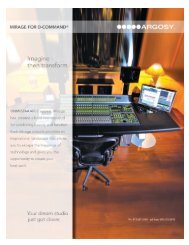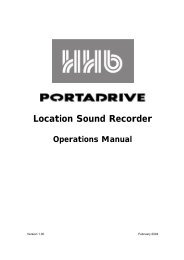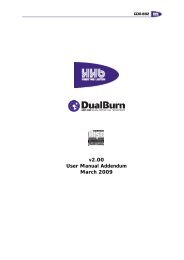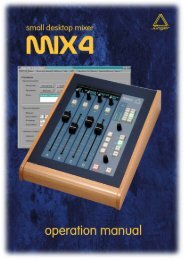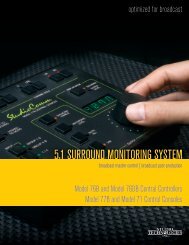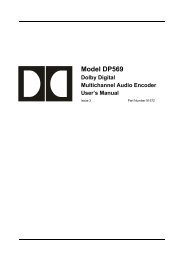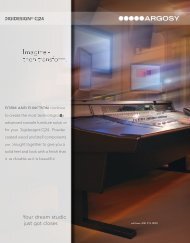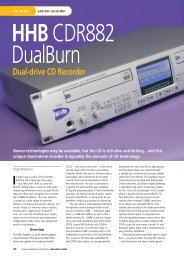Owner's Manual - Antares
Owner's Manual - Antares
Owner's Manual - Antares
You also want an ePaper? Increase the reach of your titles
YUMPU automatically turns print PDFs into web optimized ePapers that Google loves.
15<br />
Chapter 5: Realistic Expectations<br />
(or, Mic Mod EFX Meets the Space-Time Continuum)<br />
Although Mic Mod EFX seems in many ways to be almost magic, it is, in fact, simply<br />
very clever science. And as such, it remains subject to those pesky laws of physics.<br />
To get the maximum satisfaction out of Mic Mod EFX, it is important to have realistic<br />
expectations of exactly what it can and can’t do. (Most of what it can’t do relates to the physical<br />
impossibility of recovering information that wasn’t in the original signal to begin with.) Here are the<br />
main issues to be aware of:<br />
Choice of Input Microphone<br />
Luckily for all of us, the general quality of<br />
“affordable” microphones has reached a<br />
remarkably high level. Consequently, if you<br />
stick with well-known manufacturers, most any<br />
reasonable quality mic will provide sufficient<br />
performance to allow Mic Mod EFX to do its<br />
magic. (OK, we said it wasn’t magic, but we’re<br />
speaking metaphorically here.)<br />
On the other hand, you can’t expect to go into<br />
a large (but unnamed) mass merchandiser of<br />
low-cost electronics gear and pick up a $19.95<br />
mic and expect Mic Mod EFX to make it sound<br />
like a U87. If a source mic has massive roll-off<br />
in a particular frequency range, there is no<br />
way Mic Mod EFX can produce the signal that<br />
would have been captured had the source mic<br />
had better response.<br />
Microphone Variations<br />
While there are obviously major differences<br />
between various models of microphones,<br />
there are also often more subtle differences<br />
between different samples of the same model<br />
of microphone. Whether due to manufacturing<br />
variances, age, or condition, there is no<br />
guarantee that the mic we modeled will be<br />
identical to your source mic or to a specific<br />
mic you want to model. In the case of some<br />
well-known classics, we have even provided<br />
multiple models of the same (but sonically<br />
differing) mic from different sources.<br />
Microphone Technique<br />
In getting the best possible recorded sound,<br />
mic technique and placement are at least as<br />
important as mic choice (if not more so). A<br />
good engineer can record a great track with an<br />
SM57 while a poor one can make a U47 sound<br />
like doo doo. If your audio is not well-recorded<br />
in the first place, Mic Mod EFX can to do very<br />
little to improve it. If you start with a poorly<br />
recorded track, all Mic Mod EFX will do is make<br />
it sound like a track that was poorly recorded<br />
with a great mic.<br />
Excessive Frequency Boost<br />
Although Mic Mod EFX’s processing does<br />
not itself add noise to your signal, any noise<br />
in your original audio or noise added by<br />
intervening processes (e.g., A/D conversion,<br />
pre-Mic Mod EFX dynamics processing, etc.)<br />
will be accentuated by any large amount of<br />
frequency boost. This should only be a problem<br />
when your source mic has a substantial bass<br />
or treble roll-off and the modeled mic has a<br />
corresponding boost or, more likely, when your<br />
audio was recorded with a low-cut filter on<br />
the source mic and you do not use a low-cut<br />
on the modeled mic. In both of these cases,<br />
the models will apply substantial gain to the<br />
affected frequency ranges, raising the level of<br />
added noise along with the desired signal. If<br />
the resulting noise level is unacceptable, you<br />
should choose a different combination of mics<br />
and/or turn on the modeled mic’s low-cut filter.



